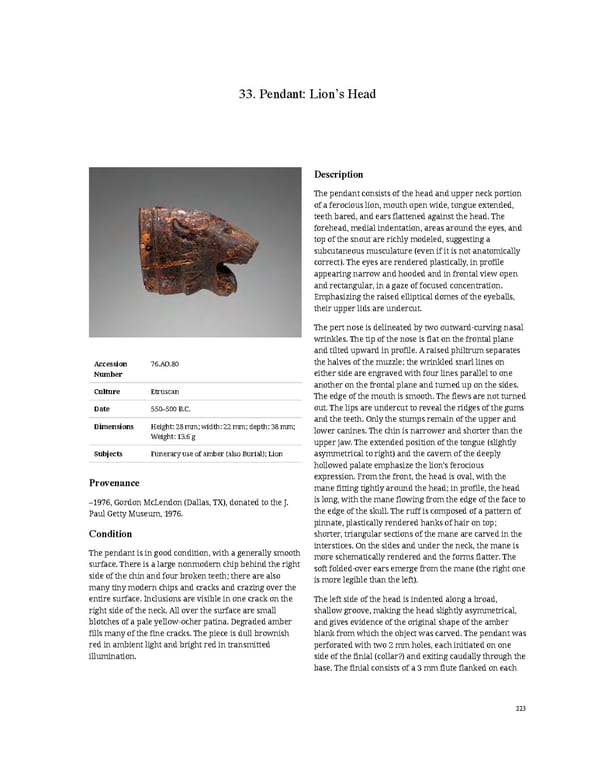33. Pendant: Lion’s Head Description The pendant consists of the head and upper neck portion of a ferocious lion, mouth open wide, tongue extended, teeth bared, and ears flattened against the head. The forehead, medial indentation, areas around the eyes, and top of the snout are richly modeled, suggesting a subcutaneous musculature (even if it is not anatomically correct). The eyes are rendered plastically, in profile appearing narrow and hooded and in frontal view open and rectangular, in a gaze of focused concentration. Emphasizing the raised elliptical domes of the eyeballs, their upper lids are undercut. The pert nose is delineated by two outward-curving nasal wrinkles. The tip of the nose is flat on the frontal plane and tilted upward in profile. A raised philtrum separates Accession 76.AO.80 the halves of the muzzle; the wrinkled snarl lines on Number either side are engraved with four lines parallel to one Culture Etruscan another on the frontal plane and turned up on the sides. The edge of the mouth is smooth. The flews are not turned Date 550–500 B.C. out. The lips are undercut to reveal the ridges of the gums and the teeth. Only the stumps remain of the upper and Dimensions Height: 28 mm; width: 22 mm; depth: 38 mm; lower canines. The chin is narrower and shorter than the Weight: 13.6 g upper jaw. The extended position of the tongue (slightly Subjects Funerary use of amber (also Burial); Lion asymmetrical to right) and the cavern of the deeply hollowed palate emphasize the lion’s ferocious Provenance expression. From the front, the head is oval, with the mane fitting tightly around the head; in profile, the head –1976, Gordon McLendon (Dallas, TX), donated to the J. is long, with the mane flowing from the edge of the face to Paul Getty Museum, 1976. the edge of the skull. The ruff is composed of a pattern of pinnate, plastically rendered hanks of hair on top; Condition shorter, triangular sections of the mane are carved in the interstices. On the sides and under the neck, the mane is The pendant is in good condition, with a generally smooth more schematically rendered and the forms flatter. The surface. There is a large nonmodern chip behind the right soft folded-over ears emerge from the mane (the right one side of the chin and four broken teeth; there are also is more legible than the left). many tiny modern chips and cracks and crazing over the entire surface. Inclusions are visible in one crack on the The left side of the head is indented along a broad, right side of the neck. All over the surface are small shallow groove, making the head slightly asymmetrical, blotches of a pale yellow-ocher patina. Degraded amber and gives evidence of the original shape of the amber fills many of the fine cracks. The piece is dull brownish blank from which the object was carved. The pendant was red in ambient light and bright red in transmitted perforated with two 2 mm holes, each initiated on one illumination. side of the finial (collar?) and exiting caudally through the base. The finial consists of a 3 mm flute flanked on each 223
 Ancient Carved Ambers in the J. Paul Getty Museum Page 232 Page 234
Ancient Carved Ambers in the J. Paul Getty Museum Page 232 Page 234